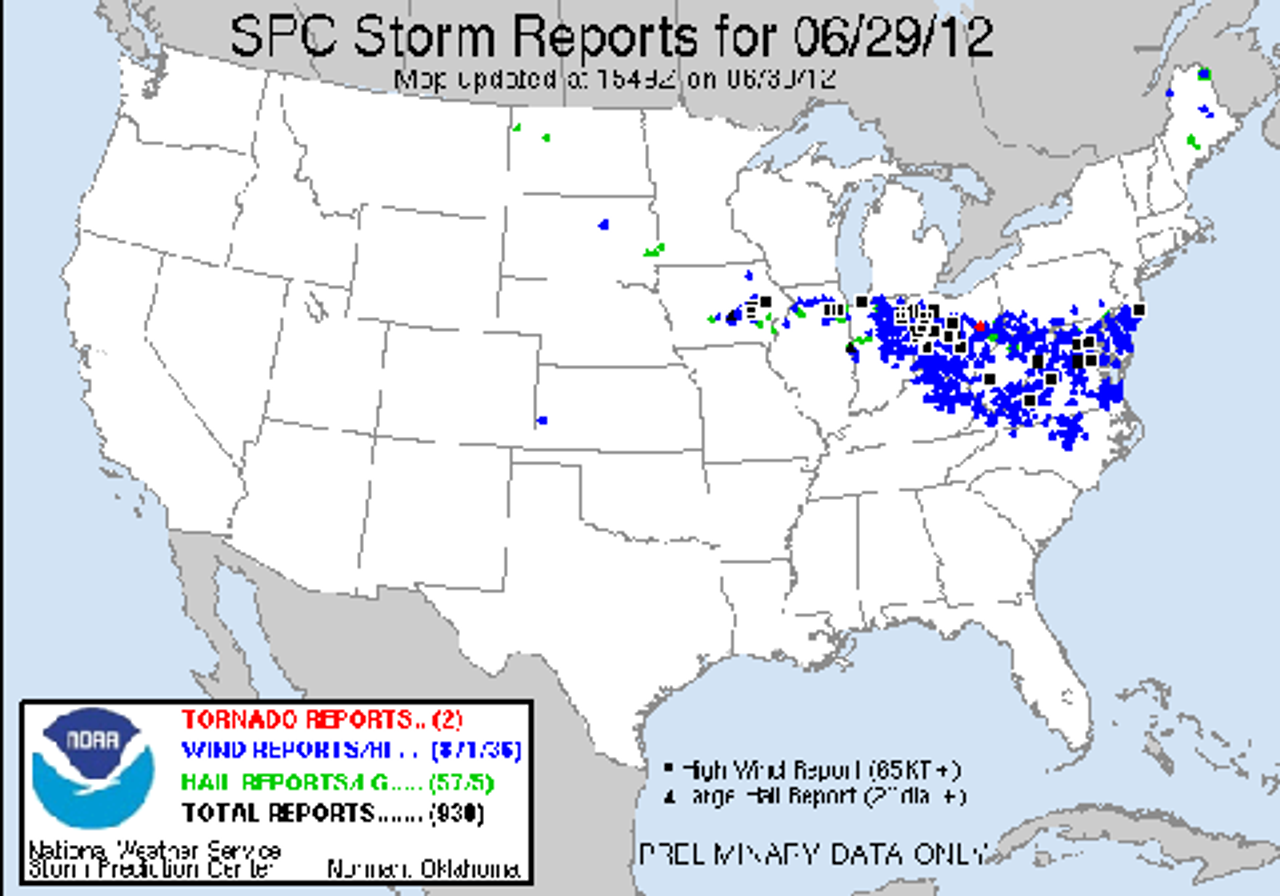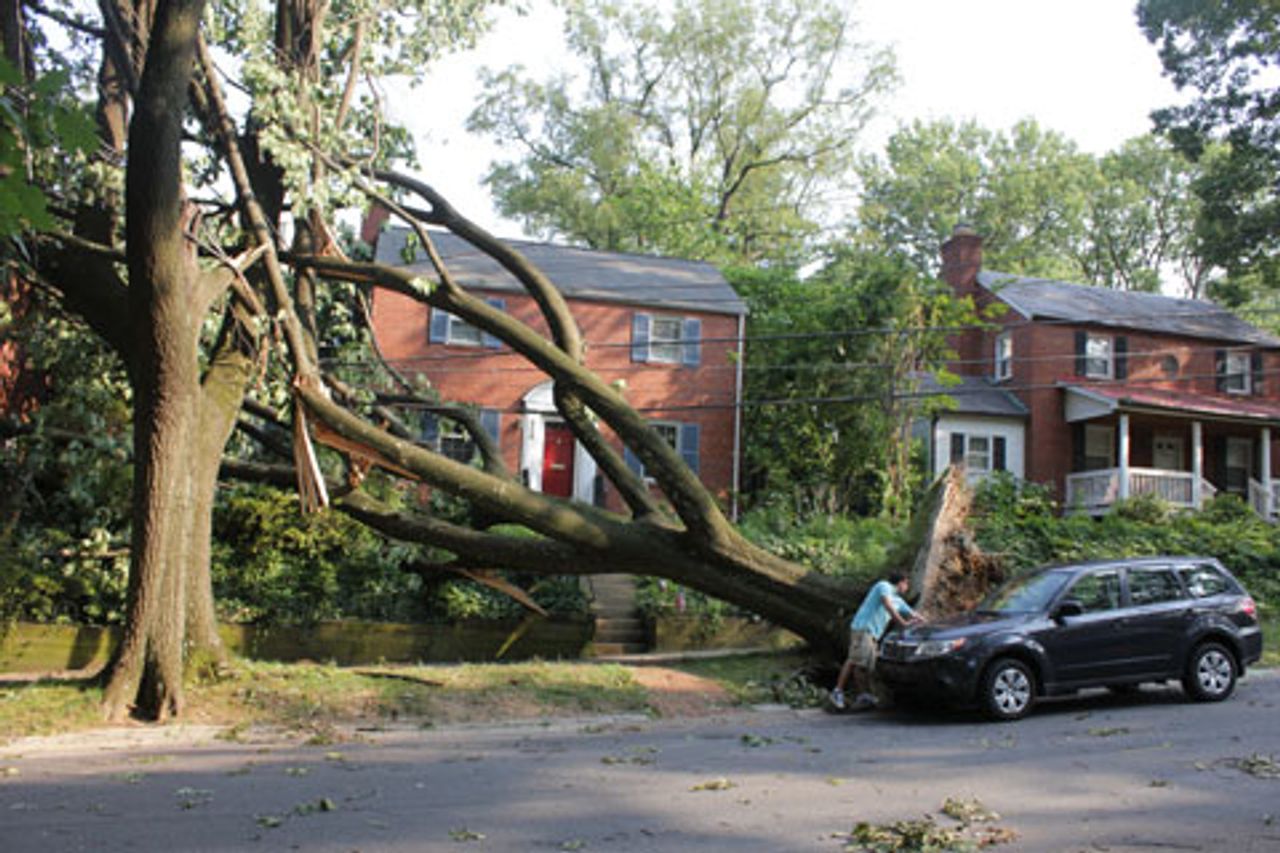Strong storms Friday left at least 14 dead and three million without power in the midst of a record heat wave across the eastern United States. The National Weather Service issued excessive heat warnings or advisories for nineteen Midwestern and Southeastern states on Sunday, where temperatures surpassed 100 degrees Fahrenheit (37.7 degrees Celsius).
A wave of storms known as a derecho moved across the Midwest on Friday, bearing winds as strong as 90 miles per hour. Record heat was the driving factor in the intensity of the system.
 The National Climatic Data Center reported that nearly 1,600 high temperature records had been broken in the last week of June. Friday was the hottest day on record for many towns, and it is just the beginning of the summer season. Nashville, Tennessee and Columbia, South Carolina reached 109 degrees; Washington, DC registered 104, breaking the previous record by two degrees. Atlanta, Georgia hit an all-time record of 106 degrees on Sunday.
The National Climatic Data Center reported that nearly 1,600 high temperature records had been broken in the last week of June. Friday was the hottest day on record for many towns, and it is just the beginning of the summer season. Nashville, Tennessee and Columbia, South Carolina reached 109 degrees; Washington, DC registered 104, breaking the previous record by two degrees. Atlanta, Georgia hit an all-time record of 106 degrees on Sunday.
Combined with high humidity, meteorologists warn that the heat index could reach 118 in some areas of the South.
Washington, DC along with the states of Ohio, Virginia, West Virginia, and Maryland declared states of emergencies due to wind damage and outages. Seven people were killed in Virginia, including a 90-year-old woman who was struck by a tree that was blown over by winds onto her home as she slept. Two New Jersey children were killed when a tree fell on their tent. Maryland has reported two deaths, and Ohio, Kentucky, and Washington all saw at least one fatality.
Two-thirds of the state of Ohio was reportedly hit by the outage, leaving more than 1 million homes and businesses without power. Governor John Kasich estimated it would take at least a week to repair the lines. The Obama administration authorized the Federal Emergency Management Agency to undertake disaster relief in the state.
Utility companies across the region have said it will take several days to a week to fully restore power. As of this writing, 2.6 million remain without electricity. For the elderly, children, and infirm residents in particular, the high heat and lack of air conditioning presents a major threat.
Washington and the surrounding Virginia-Maryland suburbs saw some of the worst damage. More than 400,000 are without power. Emergency 911 call centers were knocked out of service. “This is not a one-day situation; it is a multi-day challenge,” Virginia Governor Bob McDonnell told the press.
Large numbers of gas stations were forced to close, and residents queued in hours-long lines for fuel. Cell phone and Internet reception was also rendered patchy.
Amtrak train service between Washington and Philadelphia was halted Friday. One Chicago-bound train carrying 232 passengers was stranded in Prince, West Virginia until late Saturday night. The passengers were eventually transferred to busses to continue on their way.
 A fallen tree as a result of high winds in Washington, D.C. [Photo: woodleywonderworks]
A fallen tree as a result of high winds in Washington, D.C. [Photo: woodleywonderworks]As is always the case with weather-related disasters in the US, the decrepit state of the country’s infrastructure, and particularly its privately owned electrical grid, is exposed. The electrical lines, run above the ground, have been left to deteriorate for decades.
Power companies have been steadily freed from government safety regulation and quality standards over the past three decades, a process that has facilitated both an attack on the wages and conditions of utility workers, and on the quality and price of essential services.
Having decimated their workforces, the utility giants now rely upon the uncoordinated response of independent contractors traveling from as far away as Texas in search of work. As New York City residents contend with the heat wave, power giant Consolidated Edison announced it was locking out 8,500 workers on Sunday. Such a move all but assures brownouts, lengthy outages, and social misery.(See, “Massachusetts: Entergy suspends health care for locked-out Pilgrim power workers”.)
Although Friday’s storms were severe, power lines are just as easily downed by an ice storm or gust of wind. Indeed, major metropolitan areas have been rendered dark primarily as the result of downed tree branches. Some of the very same areas that were crippled last August by the Category-1 Hurricane Irene were once again impacted by the weekend storms.
What is clear is that nothing was done since Irene to improve line maintenance or the durability of the utilities—to say nothing of emergency preparedness and response. Indeed, municipalities across the region have been slashing budgets for fire departments, shelters, and other critical social infrastructure. At the state and federal levels, emergency response agency budgets have been left so threadbare that victims are essentially left to fend for themselves. Long lines of people waiting for bottled water in sweltering heat are an all-too-familiar sight in the American news cycle.
A telling anecdote from Baltimore, where 300,000 remain without power across the metro area and entire neighborhoods have no running water: three fire companies were slated to permanently close their doors on Sunday. The companies have been told to stay open for four extra days to cope with storm cleanup and to respond to a high volume of heat exhaustion calls.
